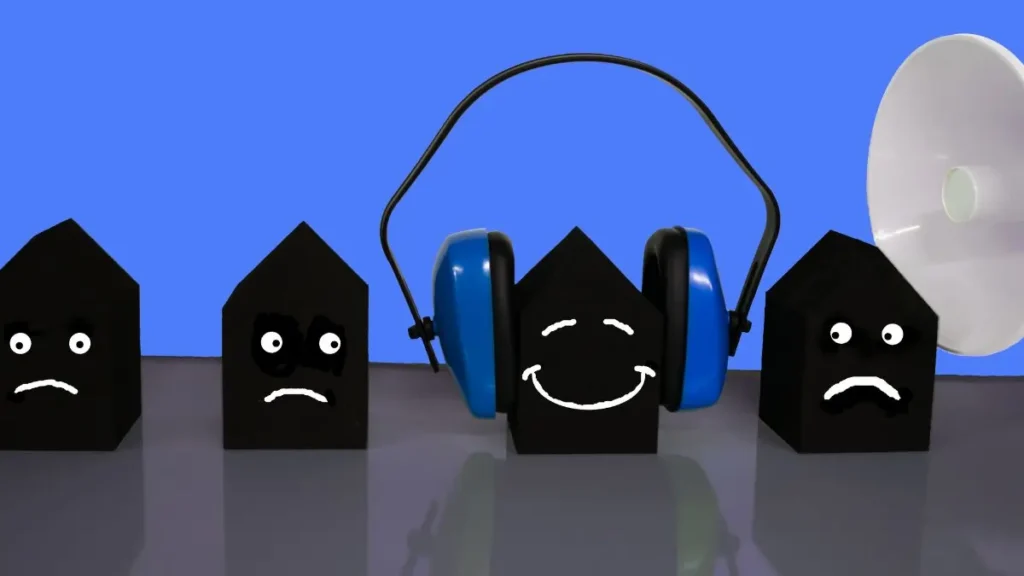Introduction to Noise Pollution
Imagine a world where unwanted sounds drown out nature’s gentle symphony. It’s a world where silence is a luxury, a fleeting moment of tranquility amidst a constant barrage of unwanted sounds. This is the grim reality of noise pollution, an invisible threat slowly but surely eroding our quality of life where noise pollution is not just an inconvenience but a silent threat to our well-being.
Noise pollution, often called the “silent killer,” is the excessive and unwanted sound that permeates our environment. From the blaring horns of traffic to the incessant hum of industrial machinery, noise pollution is an omnipresent menace that affects us all. While often overlooked, the repercussions of noise pollution are far-reaching, impacting our physical and mental well-being, disrupting ecosystems, and even contributing to economic losses.
This comprehensive exploration will delve into the multifaceted aspects of noise pollution, examining its sources, the detrimental effects on human health and the environment, and the measures that can be taken to mitigate this growing problem. By understanding the pervasive nature of noise pollution, we can empower ourselves to take action and reclaim the tranquility that is rightfully ours.
Read also: Ecosystem | Definition, Components, and 5 Important Types of Ecosystem
What is Noise Pollution?
In essence, noise pollution is any sound that causes discomfort, stress, or harm. It’s not just about loudness; even seemingly innocuous sounds, when persistent or unexpected, can be considered noise pollution. The key characteristics of noise pollution are its unwanted nature, its potential to disrupt our activities or peace of mind, and its ability to cause adverse health effects.
Unlike other forms of pollution that leave visible traces, noise pollution is often invisible and fleeting, making it easy to dismiss. However, its impacts are far from ephemeral, as we’ll explore further in this article.
The Science of Sound and Noise
To understand noise pollution, we must delve into sound science. Sound is a form of energy that travels in waves and is caused by vibrations. The intensity of sound is measured in decibels (dB). The higher the decibel level, the louder the sound. A whisper is around 30 dB, while a busy city street can reach 85 dB or more. Prolonged exposure to sounds above 85 dB can cause hearing damage.
Not all sound is noise, however. The distinction lies in the context and perception. A bird’s song may be pleasant to one person, but noise pollution may be unpleasant to another trying to concentrate. The human ear is remarkably sensitive but vulnerable to damage from excessive or prolonged exposure to loud noise.
Read also: Environmental Pollution | 7 Types of Pollution and their Alarming Effects
Sources of Noise Pollution
Urban Areas
Cities face numerous sources of noise pollution, with significant and preventable contributors stemming from traffic and industry. Motor vehicle traffic, including automobiles, motorcycles, buses, and trains, is often the most critical noise source in urban ecosystems. This noise arises from vehicle traction systems (engines, braking, exhaust), the wheel-road interface, and air displacement at high speeds.
Despite modern vehicle designs aiming to limit noise, illegal modifications to exhaust systems can create obnoxious noise, exacerbating the problem. Residential-industrial noise conflicts frequently occur due to mechanical equipment, delivery vehicles, truck backup beepers, generators, and refrigeration units. This constant barrage of loud noise in urban ecosystems can lead to headaches and disrupt the quality of life.
Read also: Why Urbanization Contributes to Pollution- 5 Alarming Facts About It
Rural Areas
Noise pollution has often affected rural areas, including agricultural activities such as heavy machinery and other irrigation systems. Transportation is another crucial factor in noise pollution. Other activities include noise from highways; air traffic could be disruptive. Industrial functioning also includes mining, logging, and other wind farms, adding to noise pollution.
Read also:

Other Sources
The airflow around the aircraft fuselage creates aerodynamic noise. It causes a loud noise that increases with aircraft speed and is more pronounced at low altitudes due to denser air. Jet-powered aircraft generate intense noise from aerodynamics, contributing significantly to the noise pollution within the ecosystem. Low-flying, high-speed military aircraft produce deafening aerodynamic noise, exacerbating the issue.
Read also:
Helicopter main and tail rotors also produce aerodynamic noise, mostly at low frequencies determined by rotor speed, adding to the loud noise levels. This constant noise pollution can cause headaches and disrupt the ecosystem’s natural balance, similar to the effects of light pollution.
Environmental Noise Pollution
While often associated with human activities, noise pollution stems from natural sources. Thunderstorms are a prime example, with their roaring thunder and torrential rain. The animal kingdom, too, contributes to the natural soundscape, with the calls of birds, insects, and other wildlife adding to the acoustic environment. However, human actions can exacerbate natural noise. Deforestation and mining activities, for instance, disrupt ecosystems and can increase noise levels in previously tranquil areas.
Read also: Air Pollution | How to Measure it and its 7 Severe Effects
Household Noise Pollution
Even the comfort of our homes is not immune to noise pollution. Appliances like vacuum cleaners, washing machines, and air conditioners generate noise, as do electronics such as televisions and music systems. DIY activities and home renovations can create temporary spikes in noise levels, while noisy neighbors and social gatherings can also contribute to household noise pollution.
Read also: What is the greatest contributor to air pollution in the United States?
Effects of Noise Pollution
While often overlooked, noise pollution is an insidious environmental hazard with far-reaching consequences for human well-being and the delicate balance of ecosystems. Prolonged exposure to excessive noise levels can trigger a cascade of adverse health effects, ranging from the obvious (hearing loss) to the more subtle (cognitive decline). Similarly, the natural world bears the brunt of our acoustic intrusions, with noise pollution disrupting animal communication, altering behaviors, and degrading habitats.
Human Health Consequences
Chronic exposure to elevated community noise levels creates significant health risks, affecting physical and mental health. The intensity of the loud noise, the duration of exposure, the context of exposure, etc., determine the effect of noise pollution on human health. Noise annoyance is a feeling of displeasure, discomfort, or offense caused by noise interference with someone’s thoughts, feelings, or actual activities. It can lead to headaches and other mental health issues.
Noise pollution isn’t just an annoyance; it’s a public health crisis. The most immediate and well-known consequence is hearing loss and tinnitus (ringing in the ears), often irreversible with chronic exposure. However, the damage extends beyond the ears.
Studies have linked noise pollution to elevated levels of stress hormones, increased risk of cardiovascular disease, and high blood pressure. Sleep disruption, another common side effect, can lead to chronic fatigue, impaired concentration, and reduced productivity. Furthermore, research suggests that noise pollution may even contribute to cognitive impairment in children, affecting their learning and development.
Overall, noise pollution threatens the well-being of individuals and the balance of the ecosystem, similar to the adverse effects of light pollution. Addressing these issues is essential for promoting healthier living environments and protecting mental health.
Mental Health Consequences
Noise pollution can significantly interfere with sleep, impacting physical and mental health. Loud noise can make it difficult to fall asleep and cause abrupt awakenings, which the sleeper may not always sense or recall. Even at levels that don’t fully awaken someone, noise can produce measurable physiological reactions, such as increased heart rate and body movements. This can disrupt natural sleep patterns by causing shifts from deep to lighter stages, making people feel “tired” or “not rested” in the morning.

Sleep disturbances can begin at relatively modest noise levels (40 dB). The proportion of people affected by sleep disturbances becomes significant at the noise level produced by a busy road. An average nighttime noise level of 65 dB will result in self-reported sleep disturbances in about 15% of the population. A noise event at 80 dB will cause awakenings in about a third of the population.
Effects on Plant Life
Noise pollution has a lasting impact on trees and plants, affecting the diversity of plant life in an ecosystem even after the noise has ceased. California Polytechnic State University researchers conducted a study revealing these long-term effects, published in Proceedings of the Royal Society B.
The U.S. National Science Foundation research was conducted near natural gas wells in New Mexico, where noisy compressors produce natural gas. The study found 75% fewer piñon pine seedlings in noisy sites compared to quiet ones. This reduction was likely due to noise driving away the Woodhouse’s scrub jay, a bird that plants thousands of pine seeds while storing them for winter. The areas became quieter after the gas companies relocated the wells and removed the compressors. However, these sites still had fewer seedlings and saplings than locations with no compressors.
Read also: Light Pollution Exposed: Unveiling Its Alarming Effects on Our Environment and Health
Habitat Displacement
The intrusion of human noise alters ecosystems, rendering previously suitable habitats inhospitable. This loud noise can lead to habitat abandonment and species displacement, potentially causing population declines and altering biodiversity dynamics. Like light pollution, noise pollution disrupts the natural environment, creating headaches for conservation efforts and impacting mental health.
Environmental and Ecological Impacts
The natural world is equally vulnerable to noise pollution, with profound implications for wildlife and ecosystems. Animals rely on acoustic communication for survival, from mating calls to predator warnings. Noise pollution can mask these vital signals, leading to disrupted behaviors, decreased reproductive success, and even mortality.
In marine environments, shipping and seismic exploration noise can interfere with whales’ and dolphins’ echolocation, causing them to strand or collide with vessels. On land, noise can force animals to abandon their habitats, increasing stress levels and reducing biodiversity. The cumulative effects of noise pollution on ecosystems are still being studied, but the evidence suggests a significant and potentially irreversible impact.
Read also: How Does Pollution Affect Animals? – 5 Tragic Effects
Strategies for Noise Pollution Mitigation and Management
The relentless onslaught of noise pollution demands a multi-pronged approach, encompassing technological innovation, legal frameworks, and individual actions. Mitigating and managing noise pollution requires a concerted effort to create quieter environments, protect human health, and preserve the delicate balance of ecosystems.
Noise Control Technologies and Practices
Advancements in technology offer a variety of tools to combat noise pollution. Strategically placed along highways and industrial areas, sound barriers can significantly reduce noise levels. Using acoustic panels and double-glazed windows, insulation in buildings and homes can create quieter indoor environments.
Urban planning plays a crucial role in noise reduction. Designing cities with designated quiet zones, incorporating green spaces to absorb sound, and promoting public transportation can all contribute to a less noisy urban environment. Additionally, the development of quieter appliances and electric vehicles offers promising avenues for reducing noise pollution at its source.
The Role of Innovation and Collaboration
Innovative solutions are essential to combat noise pollution effectively. Smart city initiatives incorporating noise mapping and monitoring technologies can help identify and address noise hotspots. Public-private partnerships are crucial for implementing noise reduction strategies on a larger scale, while community-led initiatives empower citizens to advocate for quieter environments.
Legal and Regulatory Frameworks
Effective noise pollution management relies on robust legal and regulatory frameworks. International agreements like the World Health Organization’s guidelines provide a foundation for noise control efforts. Many countries have enacted national noise regulations that set permissible noise levels for various environments and activities.
Noise monitoring and enforcement are essential components of these frameworks. Regular monitoring helps identify areas exceeding noise limits, enabling targeted interventions. Enforcement measures, such as fines and restrictions, incentivize compliance and deter excessive noise generation. Community engagement is also crucial, as involving local residents in noise management decisions can lead to more effective and equitable solutions.
Noise Regulation and Control in Urban and Rural Areas
1. Noise measurement
The decibel (dB) is widely used for measuring sound. It represents a logarithmic ratio of the sound’s power relative to the threshold of human hearing.
Sound level (dB) = 20 log10 (p measured / p ref), where p ref = 20 microscale.
Noise is assessed in frequency and intensity; the dB(A) scale weights sounds within the human audible range.
2. Urban planning and design
Urban design significantly influences the distribution of noise in cities worldwide. Various factors associated with urban planning, such as traffic volume, vehicle distribution, and traffic conditions, considerably impact noise levels. Road traffic is known to be the primary source of noise pollution from both a temporal and spatial perspective.
Effective urban planning should consider urban density, morphology, land use, street distribution, street environment, and green spaces. By fostering good relationships between these elements, cities can move closer to achieving sustainability, particularly concerning noise. Understanding these relationships enables better prediction, analysis, and prevention of sound pollution through effective urban design.
3. Technological solutions
Also known as noise walls, measures to block out high-intensity traffic noise were first tested in the United States in the 1960s and gained popularity in the 1970s with the advent of environmental laws. These measures help mitigate the impact of loud noise on ecosystems, reducing the headache-inducing effects of constant traffic noise and improving mental health. In Delft, using quiet asphalt has reduced traffic noise by 6 dB. Studies confirm that this technology’s effectiveness ranges between 4 and 6 dB.
Conclusion
In this exploration, we’ve unearthed a pervasive issue beyond mere annoyance. The consequences of unchecked noise ripple through our health, environment, and quality of life. The impacts are undeniable, from the insidious creep of hearing loss to the disruption of delicate ecosystems.
Addressing noise pollution is not a luxury but a necessity. It demands a multifaceted approach that encompasses technological innovation, stringent regulations, and a shift in societal attitudes. Quieter appliances, thoughtful urban planning, and greater awareness of noise’s detrimental effects are all crucial pieces of the puzzle.
Let us not underestimate the power of individual actions. By choosing quieter modes of transportation, supporting businesses that prioritize noise reduction, and advocating for stronger noise control measures, we can contribute to a quieter, healthier world. The fight against noise pollution is a collective endeavor requiring collaboration and commitment from individuals, communities, industries, and governments. If we choose to listen, a future where tranquility is not a luxury but a fundamental right is within our grasp.
FAQs
1. What is noise pollution, and how is it measured?
Noise pollution is excessive or unwanted sound that can disrupt human activities or harm living organisms. It’s typically measured in decibels (dB), with higher dB levels indicating louder sounds.
2. What are the main sources of noise pollution?
Noise pollution stems from a variety of sources, including:
Transportation: Road traffic, airplanes, trains, and construction vehicles are major contributors.
Industrial Activities: Factories, manufacturing, and power plants generate significant noise.
Commercial and Residential: Businesses, entertainment venues, household appliances, and even loud neighbors can create noise pollution.
3. How does noise pollution affect human health?
Noise pollution has been linked to various health issues, including:
Hearing Loss: Prolonged exposure to loud noise can damage the delicate structures of the inner ear.
Stress and Sleep Disturbances: Noise can trigger stress hormones and disrupt sleep patterns, leading to fatigue and other health problems.
Cardiovascular Issues: Studies suggest a link between noise pollution and an increased risk of hypertension, heart disease, and stroke.
Cognitive Impairment: Children exposed to high noise levels may experience difficulties concentrating, memory, and learning difficulties.
4. What are the environmental impacts of noise pollution?
Noise pollution doesn’t just affect humans; it also harms the environment and wildlife.
Disruption of Wildlife: Noise can interfere with animal communication, mating rituals, and navigation, leading to behavioral changes and habitat displacement.
Stress and Physiological Changes: Animals exposed to chronic noise can experience elevated stress levels, suppressed immune systems, and reproductive problems.
Marine Life Disruption: Underwater noise from shipping and sonar can negatively impact marine mammals and fish populations.
5. What can be done to reduce noise pollution?
Various measures can be taken to mitigate noise pollution:
Technological Solutions: Quieter engines, sound barriers, and soundproofing materials can reduce noise levels.
Urban Planning: Designing cities with green spaces, pedestrian-friendly areas, and noise-reducing infrastructure can make a significant difference.
Regulation and Enforcement: Governments can enact and enforce noise regulations to limit excessive noise from various sources.
Individual Actions: People can use ear protection, choose quieter appliances, and be mindful of their noise levels.
6. Are there any international efforts to address noise pollution?
Yes, several international organizations are working to address noise pollution:
World Health Organization (WHO): The WHO has issued guidelines on safe noise levels and promotes research on the health effects of noise.
European Union (EU): The EU has implemented directives to reduce noise pollution from transportation and industrial sources.
Various NGOs: Numerous non-governmental organizations advocate for noise reduction and raise awareness about its impacts.
7. What can individuals do to reduce noise pollution?
While tackling noise pollution requires a collective effort, individuals can play a role in reducing its impact. Some actions you can take include:
Be mindful of your noise levels: Keep music and other sounds at a reasonable volume.
Use quieter appliances: Opt for quieter models when purchasing household appliances and power tools.
Support noise reduction initiatives: Advocate for stronger noise regulations and support organizations working to combat noise pollution.
Plant trees and vegetation: Trees and shrubs can act as natural sound barriers.
Use ear protection: In noisy environments, use earplugs or earmuffs to protect your hearing.
Reference
- (N.d.-b). Earthjournalism.net. Retrieved May 22, 2024, from https://earthjournalism.net/resources/noise-pollution-managing-the-challenge-of-urban-sounds
- (N.d.-c). Sciencedirect.com. Retrieved May 22, 2024, from https://www.sciencedirect.com/science/article/abs/pii/0003682X75900286
- National Science Foundation. (2021, April 27). Effects of noise on plants persist over long periods. National Science Foundation. https://new.nsf.gov/news/effects-noise-plants-persist-over-long-periods
- AnuMeena Care Foundation. (2023, August 27). Noise pollution : Harm to animals. Linkedin.com. https://www.linkedin.com/pulse/noise-pollution-harm-animals-anumeenacare
- (N.d.-d). Researchgate.net. Retrieved May 22, 2024, from https://www.researchgate.net/publication/325783443_Noise_Pollution_and_Urban_Planning
- 6 technical solutions to reduce noise pollution. (n.d.). Tomorrow.City – The Biggest Platform about Urban Innovation. Retrieved May 22, 2024, from https://www.tomorrow.city/technical-solutions-reduce-noise-pollution/





